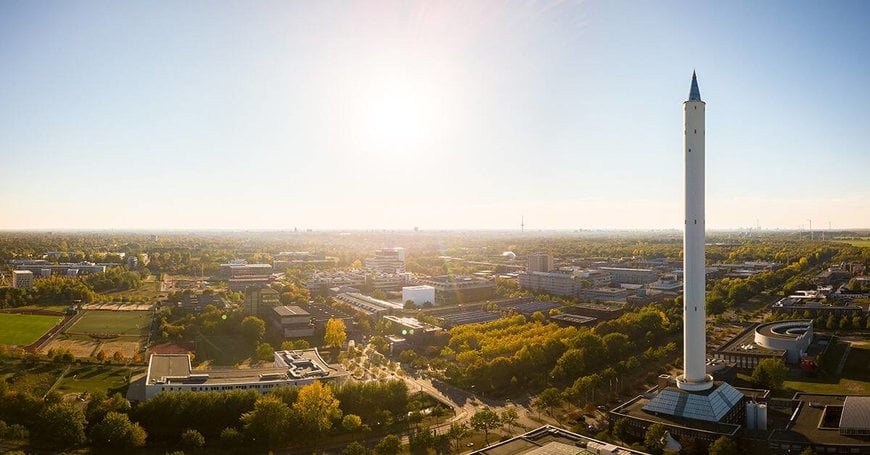railway-international.com
07
'23
Written on Modified on
Precision sensor technology for microgravity research
Researchers in need of conducting a scientific experiment in zero gravity have a choice: They could pack it onto a satellite or the International Space Station, or take it on a special plane – a parabolic flight that achieves nearweightlessness.Or they could save a lot of hassle, expense and fuel to conduct their experiment on the ground – for instance at the Bremen Drop Tower, a research lab offering the world’s most advanced microgravity conditions.

The Drop Tower is part of the Center of Applied Space Technology and Microgravity (ZARM) at the University of Bremen, which has been leveraging ASC sensor technology for many years. Space research at the University of Bremen
ZARM is an internationally recognized space research center with multidisciplinary expertise stretching from fundamental experimental, theoretical and computational research to the development of technologies for space missions. In its cutting-edge microgravity laboratories, scientists from all over the world can conduct their own microgravity experiments.
“Our main microgravity lab is the Bremen Drop Tower,” says Anna Becker, research fellow at ZARM. “It allows for short-term experiments in near weightlessness conditions – one millionth of earth gravity. This is the only lab of its kind in Europe.” The 146-meter-tall tower facilitates two types of testing: the free drop of an experiment capsule of around 5 seconds through a vacuum tube; as well as the vertical acceleration of the capsule by means of a catapult system. During both the ascent and the ensuing descent, the capsule remains ‘weightless’ which doubles the available experiment time. This achieves a microgravity research duration unmatched by any other drop tower in the world.
The demand for drop tower experiments is high. Teams from all over the world and diverse scientific fields book the Bremen Drop Tower typically many months in advance.
High performance sensor solutions for microgravity simulation
“However, to enable our research facilities to produce the required space conditions we need to constantly monitor them through high precision sensor technology,” says Becker.
For years, ZARM has been using triaxial gyroscopes and accelerometers by ASC at various points of the experiment capsule, currently the latest models from the ASC 283 and ASC EQ series. “More than anything we rate the reliability of these sensors.”
A critical parameter for researchers is ultra-low residual acceleration in the experiment. “To be able to reasonably capture these tiny acceleration forces, we depend on very low noise level emission,” explains Becker. The ASC EQ-3211-005 meets lowest noise level standards while also achieving the lowest resolutions beneath 1 µg. “Without that combined performance, we would be unable to validate the desired 10-6 g microgravity quality.”
The ASC 283-010 tactical grade performance gyroscopes‘ extremely narrow measuring range of +/-10 °/s allows for highest resolution capturing of minimal angular velocities that are typically observed during drop tests. “We are planning to install these sensors in our next generation drop towers for controlled rotation rate reduction during experiment.”
At the same time, all sensor equipment embedded in the drop tower capsule needs to resist significant acceleration and deceleration forces of up to 50 g as the capsule is catapulted up and abruptly stopped again on its way down.
Next generation microgravity research
To achieve this high quality microgravity in the Bremen Drop Tower, ahead of each experiment 1,700 m3 of air need to be pumped out of the drop tube to produce a vacuum. This takes time, so that no more than three individual experiments can take place on any given day. To increase capacity and allow for repetitive testing where results can be reproduced and validated, ZARM recently launched its novel GraviTower Bremen Pro in 2022.
The new facility achieves similar microgravity quality as the Drop Tower, however, without need for a vacuum. To do this, air resistance is compensated by a rope drive moving the experiment capsule up and down through the 16-meter-high GraviTower, simulating the catapult effect of the Drop Tower. An airtight slider shields the experiment from the detrimental effects of air drag. During the weightless phase, the slider and experiment do not touch each other so that vibrations and other disruptive factors are not transferred to the experiment.
Sensor solutions ‘for moon and Mars’
“Without the need for producing an actual vacuum, the new facility can carry out 20 experiments per hour each of 2.5 seconds microgravity duration,” Becker confirms. With this, ZARM now offers not only the longest microgravity duration but also the world’s highest repetition rate for individual experiment set ups.
“Based on our positive experience with ASC’s sensors, ZARM is equipping the GraviTower with similar triaxial gyroscopes,” Becker says. “In a current project the sensors will be utilized to control linear motors to simulate moon and Mars gravity conditions.”
A distinct advantage is the fact that each sensor can be configured individually. To fit in the tiniest spaces, a lot of technology needs to be integrated in extremely compact sensor housing designs. “For the ZARM team, this is invaluable. We would often struggle to accommodate standardized sensors.”
It further helps that the sensors come with removable cables, which means they are easily taken out for recalibration without a need to uninstall the complete wiring, each time.
The future is here
“It helps that ASC’s sensor solutions are already fit for the future,” Becker concludes. “Digital and smart sensors play an increasing role. Especially with the fully automated GraviTower, for instance, sensor data can help detect and predict variations in testing conditions in real time. It is only with smart technology that we are able to fully leverage the potential of this highly sophisticated research facility and strengthen scientific outcomes through predictive data analyses. The future of microgravity research is already happening in Bremen, one might say.”
www.asc-sensors.de

